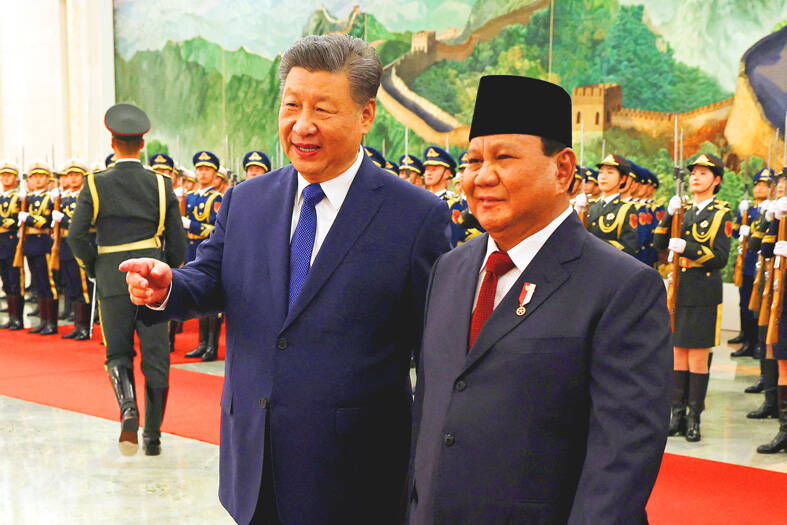Indonesia yesterday said it does not recognize China’s claims over the South China Sea, despite signing a maritime development deal with Beijing, as some analysts warned the pact risked compromising its sovereign rights.
Beijing has long clashed with Southeast Asian neighbors over the South China Sea, which it claims almost in its entirety, based on a “nine-dash line” on its maps that cuts into the exclusive economic zones (EEZ) of several countries.
Joint agreements with China in the strategic waterway have been sensitive for years, with some nations wary of deals they fear could be interpreted as legitimizing Beijing’s vast claims.

Photo: Reuters
In 2016, an arbitral tribunal said the Chinese claim, based on its old maps, has no basis in international law, a decision China refuses to recognize.
A joint statement issued at the weekend during Indonesian President Prabowo Subianto’s visit to Beijing mentioned the two countries had “reached important common understanding on joint development in areas of overlapping claims.”
The Indonesian Ministry of Foreign Affairs has repeatedly said the country is a non-claimant state in the South China Sea and has no overlapping jurisdiction with China.
Yesterday, the ministry said its position was unchanged and the agreement would have no impact on its sovereign rights.
“Indonesia reiterates its position that those [Chinese] claims have no international legal basis,” it said.
“The partnership does not impact sovereignty, sovereign rights or Indonesia’s jurisdiction in the North Natuna Sea,” it said.
The Chinese Ministry of Foreign Affairs said the clause “clarifies the political consensus and direction of co-operation between the two sides on joint development in the overlapping maritime areas claimed by the two countries.”
Chinese ministry spokesperson Lin Jian (林劍) said Indonesia and China would further explore topics such as the content and mode of cooperation, adding that there was a historical basis for China’s South China Sea claims and that consensus would benefit both.
China’s U-shaped line, based on its old maps, begins off central Vietnam and runs into waters off Indonesia’s Natuna islands, more than 1,000km south of the Chinese island of Hainan.
It crosses into the EEZs of Brunei, Malaysia, the Philippines and Vietnam, and is patrolled by an armada of the Chinese coast guard, which neighbors accuse of aggression and seeking to disrupt energy and fisheries activity.
China typically says its vessels are preventing incursions into its territory.
The Indonesian ministry said the economic agreement on maritime issues with China covered fisheries and fish conservation, and hoped it would be a model to safeguard peace and friendship.
However, some Indonesian analysts said that signing such an agreement could have repercussions and be interpreted as a change in stance.
“If we refer to the official joint statement, that means we recognize overlapping claims,” maritime analyst Aristyo Rizka Darmawan said, adding that it could compromise Indonesia’s sovereign rights to exploit resources in its EEZ.
Indonesia might have signed the agreement with the intention of boosting economic ties, he added.
Klaus Heinrich Raditio, a lecturer in Chinese politics, said Indonesia never had overlapping claims to begin with and the clause’s inclusion in the statement was “inappropriate.”
“This joint statement puts our national interests at risk,” he said, adding that it could still be renegotiated.

DEATH CONSTANTLY LOOMING: Decades of detention took a major toll on Iwao Hakamada’s mental health, his lawyers describing him as ‘living in a world of fantasy’ A Japanese man wrongly convicted of murder who was the world’s longest-serving death row inmate has been awarded US$1.44 million in compensation, an official said yesterday. The payout represents ¥12,500 (US$83) for each day of the more than four decades that Iwao Hakamada spent in detention, most of it on death row when each day could have been his last. It is a record for compensation of this kind, Japanese media said. The former boxer, now 89, was exonerated last year of a 1966 quadruple murder after a tireless campaign by his sister and others. The case sparked scrutiny of the justice system in

The head of Shin Bet, Israel’s domestic intelligence agency, was sacked yesterday, days after Israeli Prime Minister Benjamin Netanyahu said he no longer trusts him, and fallout from a report on the Oct. 7, 2023, Hamas attack. “The Government unanimously approved Prime Minister Benjamin Netanyahu’s proposal to end ISA Director Ronen Bar’s term of office,” a statement said. He is to leave his post when his successor is appointed by April 10 at the latest, the statement said. Netanyahu on Sunday cited an “ongoing lack of trust” as the reason for moving to dismiss Bar, who joined the agency in 1993. Bar, meant to

DITCH TACTICS: Kenyan officers were on their way to rescue Haitian police stuck in a ditch suspected to have been deliberately dug by Haitian gang members A Kenyan policeman deployed in Haiti has gone missing after violent gangs attacked a group of officers on a rescue mission, a UN-backed multinational security mission said in a statement yesterday. The Kenyan officers on Tuesday were on their way to rescue Haitian police stuck in a ditch “suspected to have been deliberately dug by gangs,” the statement said, adding that “specialized teams have been deployed” to search for the missing officer. Local media outlets in Haiti reported that the officer had been killed and videos of a lifeless man clothed in Kenyan uniform were shared on social media. Gang violence has left

‘HUMAN NEGLIGENCE’: The fire is believed to have been caused by someone who was visiting an ancestral grave and accidentally started the blaze, the acting president said Deadly wildfires in South Korea worsened overnight, officials said yesterday, as dry, windy weather hampered efforts to contain one of the nation’s worst-ever fire outbreaks. More than a dozen different blazes broke out over the weekend, with Acting South Korean Interior and Safety Minister Ko Ki-dong reporting thousands of hectares burned and four people killed. “The wildfires have so far affected about 14,694 hectares, with damage continuing to grow,” Ko said. The extent of damage would make the fires collectively the third-largest in South Korea’s history. The largest was an April 2000 blaze that scorched 23,913 hectares across the east coast. More than 3,000